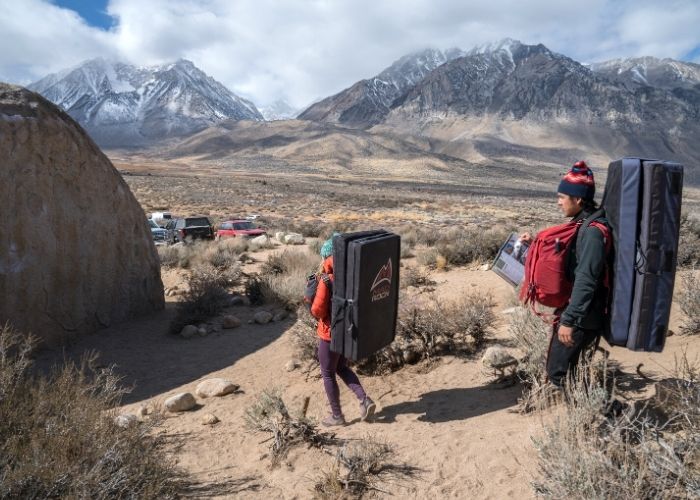Bouldering for Beginners

By Hannah Desmond
What exactly is bouldering? Bouldering is climbing on small rock formations or artificial rock walls without the use of ropes or a harness. At first it can seem scary or too hard, but with the right safety precautions and knowledge, it can be really fun! It's a great way to break into the climbing scene without buying an obscene amount of gear.
SAFETY
Bouldering can be scary at first, especially for those who find comfort in a harness, but it's a great way to get out on some good rock without purchasing a ton of equipment and learning how to lead climb. Below are a few tips to get you started.
- Warm up before grabbing the rock. Raise your heart rate, focus on building strength, and slowly build up the level of difficulty you attempt.
- Do not try to climb beyond your experience level.
- Watch out for the climbers around you. They may be above or beside you, and could even serve as your spotters. (Spotters are people on the ground to assist you in climbing and aid you if you fall).
- Make sure your crash pad is well positioned with each climb.
- Rest between attempts. A good rule of thumb is to rest for 10 minutes after every 30 minutes of climbing. Listen to your body and adjust this number as your endurance matures. Take care to stretch your legs during breaks.
- When attempting high risk moves, make sure you are fully warmed up, be mindful of a foot or hand slipping, be as controlled as possible, and take fewer tries with longer rests in between. Make certain your crash pad is well positioned.
- Be aware of pockets, small sharp edges, and slopers.
- Emphasize quality. Avoid bouldering after doing hard routes, and recognize when your body needs to rest before losing form.
- Make sure to cool down after your climb.

TIPS & TRICKS
Now that you’re ready to boulder safely, here’s a few tips and tricks to get you up that rock.
- Always place your big toe on holds instead of your instep.
- Always keep your hips close to the wall to conserve upper body strength.
- Try to keep your feet directly below you.
- Once you find a foothold, keep your foot still.
- Keep your heel low to increase friction.
- Straightening your arms takes most of the weight from your muscles and puts it on the skeleton instead.
JARGON AND HOLDS
HANDHOLDS
Sidepulls are holds with openings on the sides. While using a sidepull, wrap your fingers around the side while leaning your hips in the opposite direction.
Underclings are holds with openings on the bottom. While using an undercling, grasp the hold underhand, bring your feet high and push up with them while keeping your hips close to the wall.
A crimp is a small edge that you need to grab with your fingers more than your palm. Place your fingertips on the hold’s edge, curl your fingers by bending them at the middle knuckle, and then press your thumb on the fingernail of your index finger to lock it all in place.
A sloper is basically the opposite of a crimp. Slopers are large round holds that you can’t wrap your whole hand around. Use it to hold your body in place while moving your feet up, keep your hips low and to the wall, and press the most with your fingertips.
Pinches are holds that require your thumb as well as the other fingers. Pinch holds are very basic, but they require a lot of strength. Imagine pinching like a crab’s claw.
Pockets are holes that have eroded into the wall over time. If you can fit two fingers in the hole, it’s better to use your middle and index finger. If only one finger can fit, your middle finger is the best to go with.
FOOTHOLDS
Smearing is when you don’t have an actual foothold, so you use shoe’s friction against the rock instead. When you smear, look for small depressions or anything that could give you a little extra friction. Depending on the smear, sometimes it is better to flatten your foot than just standing on your toes.
A drop knee is when you twist your leg so that instead of using your big toe to stand, you are using your pinky toe. This may seem unusual but it can help make more physically demanding moves much easier. To perform a drop knee, place your foot on the hold, and then twist your leg until your knee is facing down and towards your centre.
A layback is a move used during a sidepull when you have nothing else to oppose it. In performing a layback, you must lean away from the hold to find a position of balance. This will make your body look like a 7 with the top being your arms and the bottom being your legs.
Toe and heel hooks are very similar. They are used when climbing upside down or on a vertical edge. They both follow the same principal, using one of your legs as a third arm. One would use toe hooks by hooking their toes up and over something while climbing upside down, and do the same with the heel for a heel hook.
And, last but not least, a bridge is when someone has a foot on each side of a corner and uses the hold to either balance themselves or give their hands a break.
Watch some of these moves at a fantastic bouldering spot in Central Oregon by clicking here.